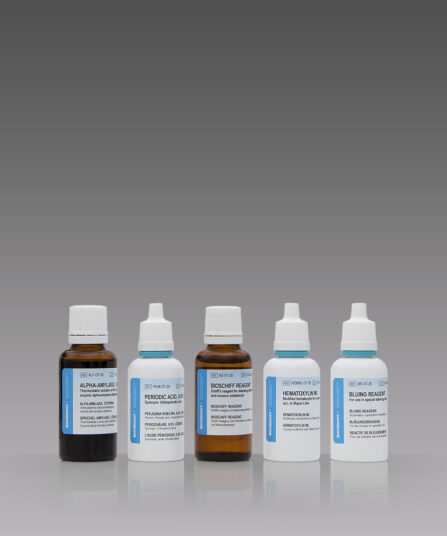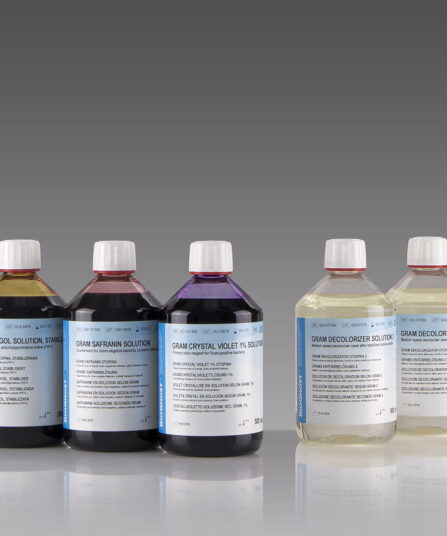Paraldehyde Fuchsin kit is used for visualisation and detecting pathologic changes in elastic fibres, such as elastic tissue atrophy, loss or thinning of elastic tissue caused by atherosclerotic changes or vascular diseases. Often used for staining pancreatic beta cells, mastocyte granules, mucins, cartilage, argentaffin granules and acrosome of the sperm.
Paraldehyde Fuchsin kit
Seven-reagent kit according to Gomori for detecting pathological changes in elastic fibres. It also stains mast cell granules, beta granules in pancreatic islets, neurosecretory material, mast cell granules and beta cells in the pituitary gland.
Description
Additional information
| Size | |
|---|---|
| Brand | |
| Stain pack | |
| Stain Category | Muscle and Connective Tissue |
Related products
Stains Reagents And Dyes
Rapid Romanowsky (Diff Quik) Stain Kit 3×0.5L
Stain Kits
Gomori Trichrome kit
Five-reagent kit for staining muscle, collagen fibre and nuclei, contains blue counterstain. The kit can be used to contrast skeletal, cardiac or smooth muscle.
Stain Kits
BioGram Histo kit
Five-reagent kit for identification of bacteria according to Gram. For differentiation between Gram-positive and Gram-negative bacteria in histology sections.
Papanicolaou Rapid Staining Kit, for 100 Tests
Ready-to-use eight-reagent kit (in 18 containers that can be used as staining jars) for rapid progressive gynecology and non-gynecology cytological samples. Contains xylene substitute as clearing agent and xylene substitute-based medium for permanent covering of samples.
PAP-100T for 100 tests
Stain Kits
TB-Stain Fluorescent Kit
Three-reagent kit for fluorescence-microscopic detection of acid-fast bacteria. Contains TB Auramine-Rhodamine reagent, double amount of TB Decolorizer Fluorescent and TB Permanganate reagent as counterstain.
4 x 100ml bottles.
Stain Kits
P.A.S. Diastase Kit
BioGnost’s P.A.S. Diastase kit is most commonly used for identifying glycogen in liver. Periodic acid enables the molecules containing glycol groups to create aldehydes affected by Schiff’s reagent staining them violet (magenta). Specific stains are created by applying the PAS method on unsubsti-tuted polysaccharides, mucoproteins and glycoproteins, glycolipids and phospholipids. Alpha-amylase enzyme (also known as diastasis) is used for differentiation between glycogen and other PAS-positive structures by dissolving 1→4 glycosidic bonds, causing the glycogen to remain unstained after the PAS reaction. BioGnost’s P.A.S. Diastase kit uses thermostable enzyme which does not require heating to +37°C to be active, but incubat-ing the section at +37°C is preferred in order to achieve better glycogen breakdown. The same tissue section is used as negative control for this reaction, but the sample is not treated using alpha-amylase.
For 100 tests.
Stain Kits
BioGram ECO kit
Four-reagent phenol-free kit for the identification of bacteria according to Gram. Kit contains Gram Crystal violet, phenol free reagent, Gram Sodium hydrogencarbon, solution, stabilized Gram Lugol solution, double amount of Gram Decolorizer solution 2 and Gram Safranin solution as counterstain.
2×50 mL+4×100 mL bottles
Stain Kits
BioGram 4 kit
Four-reagent kit for identification of bacteria according to Gram. Kit contains Gram Crystal Violet 1% solution, stabilized Gram Lugol solution, double amount of Gram Decolorizer solution 2 and Gram Safranin solution as counterstain.
5×100 ml bottles











